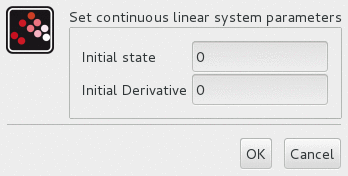
#Scilab derivative how to
The apparent errors are caused by // cancellation in the floating point operations, so a " big " h is chosen. This video explains how to solve first and second order differential equation in SCILAB using inbuilt function 'ODE'. StaticCalciumRightKneeMuscles/ActuationDynamics.scilab, Compute the generalized Torques and derivative of tightness and forces of muscles BipActuators/. A = rand ( 3, 3 ) p = rand ( 3, 1 ) w = 1 x = rand ( 3, 1 ) = derivative ( list ( f, A, p, w ), x, h = 1, H_form = ' blockmat ' ) // Since f(x) is quadratic in x, approximate derivatives of order=2 or 4 by finite // differences should be exact for all h~=0. dx ) // A trivial example function y = f ( x, A, p, w ) y = x ' * A * x + p ' * x + w endfunction // with Jacobian and Hessian given by J(x)=x ' *(A+A ' )+p ', and H(x)=A+A '.
#Scilab derivative series
for i = derivative ( F, x, order = i, H_form = ' blockmat ', Q = Q ) mprintf ( " order= %d \n ", i ) H, end p = 1 h = 1e-3 = derivative ( list ( G, p ), x, h, 2, H_form = ' hypermat ' ) H = derivative ( list ( G, p ), x, h, 4, Q = Q ) H // Taylor series example: dx = 1e-3 * = derivative ( F, x ) F ( x + dx ) F ( x + dx ) - F ( x ) F ( x + dx ) - F ( x ) - J * dx F ( x + dx ) - F ( x ) - J * dx - 1 / 2 * H * ( dx. resulting in a maximum overshoot value of 3.6% and a peaktime value of 3.Function y = F ( x ) y = endfunction function y = G ( x, p ) y = endfunction x = derivative ( F, x, H_form = ' blockmat ' ) n = 3 // form an orthogonal matrix : Q = qr ( rand ( n, n ) ) // Test order 1, 2 and 4 formulas. derivatives can often by gotten by using the Scilab function derivative. The simulation tools in Scilab use backward differentiation formulas (BDF). 4.7.1 Higher Derivatives Sometimes it is desirable to have higher derivatives. In the first part, we briefly report the first order forward formula, which is based on the. Scilab/Scicos is the only open-source alternative to commercial packages for. The system performance characteristics produced in the tuning process are 3.994 seconds of settling time at 2.36 seconds research time. This document present the use of numerical derivatives in Scilab. of following function: 3e 2x The requirements: Solve the derivatives for 0 <2. From the system simulation results, the best parameter is obtained through the Zieglar Nichols PID tuning process based on the results of the transient response analysis, namely when the proportional gain value (K p) is 50. The exact solution is: 607 ( E (42+1) Use Scilab function to provide. When this is zero the function may be at a minimum/. The second method is automatic tuning which is done through mathematical calculations to obtain PID control constants, namely Zieglar Nichols PID tuning with the oscillation method. First derivatives are often used to get the slope of a function. The value adjustment of system control parameters is carried out with several variations, namely K p control variation, K p variation to constant K d, K d variation to constant K p, K p variation to K i, constant K d, variation of K i to K p, constant K d and variation of K d to K p, K i constant.
#Scilab derivative trial
The method used is the trial and error method by setting and varying the values of the control constants K p, K i, and K d to produce the desired system response. Example revisited Recall the problem statement for numerical solution: dx dt 2 + 18t + 68t2 + 180t3.




In this research, P, PD, and PID control simulations with the transfer function of the mass-damper spring as a plant using Xcos Scilab. Scilab, that is the management of real matrices and overview the linear algebra library. But what is the command to find approximate derivative of f (x,y) wrt x or y at some value. This control has controlling parameters, namely K p, K i, and K d which will have a control effect on the overall system response. command for derivative of a multivariable function Submitted by Viswanath Pasumarthi on Wed, - 01:14 The function 'derivative' works fine for computing approximate derivative of a function f (x). Extension of transport of intensity equation to partially coherent fields. PID (Proportional Integral Derivative) control is a popular control in the industry and aims to improve the performance of a system. Axial intensity derivative estimation and the noise problem. Define a discrete time system and plot its step response Discretize a continuous time system Slide 3- System Requirement slide I am using Ubuntu 12.04 operating system with Scilab 5.3.3 for demonstation Slide 4- Prerequisite slide To practise this tutorial, you should have basic knowledge of Scilab. P control, PD, PID, PID tuning, Xcos Scilab, Zieglar-Nichols Abstract


 0 kommentar(er)
0 kommentar(er)
